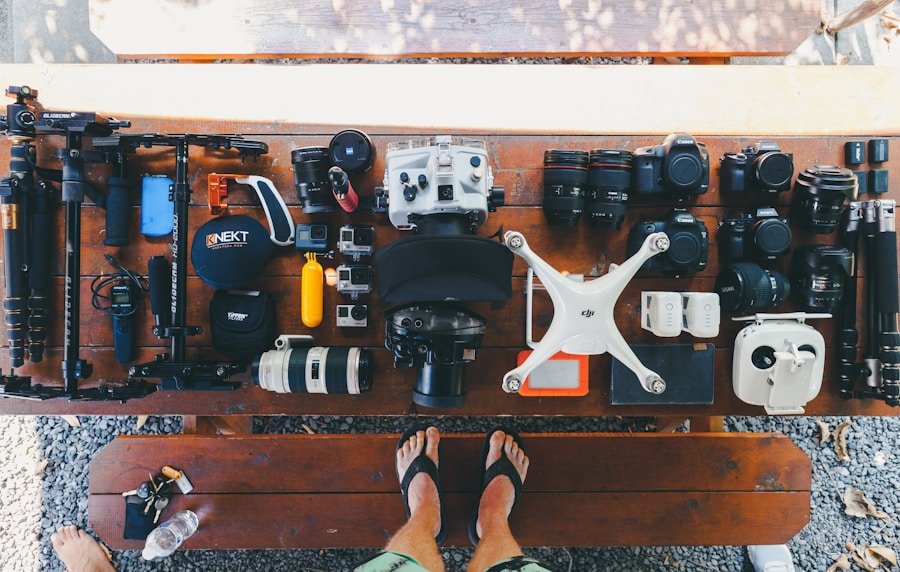Drones, also known as unmanned aerial vehicles (UAVs), are aircraft that are operated without a human pilot on board. They can be controlled remotely by a pilot on the ground or can be programmed to fly autonomously. Drones come in a variety of shapes and sizes, from small quadcopters to large fixed-wing aircraft. They are equipped with various sensors, cameras, and other technology that allow them to perform a wide range of tasks, from aerial photography and videography to surveying and mapping.
Drones operate using a combination of GPS, sensors, and onboard computers to navigate and maintain stability in the air. They are powered by electric motors and are typically equipped with rechargeable batteries. Drones have become increasingly popular in recent years due to their versatility and affordability. They are used in a wide range of industries, including agriculture, construction, filmmaking, and search and rescue. As the technology continues to advance, drones are becoming more accessible to the general public, and many people are now purchasing their own drones for recreational use.
Factors to Consider When Choosing Your First Drone
When choosing your first drone, there are several factors to consider to ensure that you find the right one for your needs. The first thing to consider is your budget. Drones can range in price from a few hundred dollars to several thousand dollars, so it’s important to determine how much you are willing to spend before you start shopping. Next, consider what you will be using the drone for. If you are interested in aerial photography or videography, you will want a drone with a high-quality camera and stable flight capabilities. If you are more interested in racing or performing stunts, you will want a drone with agile maneuverability and a durable frame.
Another important factor to consider is the drone’s flight time and range. The flight time refers to how long the drone can stay in the air on a single battery charge, while the range refers to how far the drone can fly from the pilot before losing connection. Additionally, consider the drone’s size and portability. If you plan on traveling with your drone or flying it in tight spaces, you will want a smaller, more compact model. Finally, consider the level of skill required to operate the drone. Some drones are designed for beginners and come with features like automatic takeoff and landing, while others require more advanced piloting skills.
Top Beginner-Friendly Drones on the Market
There are many beginner-friendly drones on the market that are perfect for those who are new to flying. One popular option is the DJI Mavic Mini, which is a compact and lightweight drone that is easy to fly and has a high-quality camera for capturing stunning aerial photos and videos. Another great option is the Holy Stone HS100 GPS Drone, which comes with built-in GPS and a range of intelligent flight modes that make it easy to control and navigate. The Syma X5C is another affordable and beginner-friendly drone that is perfect for learning the basics of flying.
For those interested in racing and performing stunts, the EMAX Tinyhawk is a great option. It is a small and agile drone that is perfect for indoor flying and learning how to perform tricks and maneuvers. The Blade Inductrix FPV is another popular choice for beginners who are interested in racing drones. It comes with a first-person view (FPV) camera that allows you to see what the drone sees as you fly it, providing an immersive flying experience.
Essential Accessories for Your First Drone Flight
When preparing for your first drone flight, there are several essential accessories that you will need to ensure a successful and enjoyable experience. The most important accessory is a set of spare batteries. Drones typically have a relatively short flight time, so having extra batteries on hand will allow you to extend your flying time without having to wait for the batteries to recharge. Additionally, consider purchasing a battery charger that can charge multiple batteries at once for added convenience.
Another essential accessory is a memory card for your drone’s camera. This will allow you to capture and store high-quality photos and videos without running out of storage space. Additionally, consider investing in a carrying case or backpack to transport your drone and its accessories safely and conveniently. This will help protect your drone from damage during travel and make it easier to bring it with you on outdoor adventures.
Finally, consider purchasing propeller guards to protect your drone’s propellers from damage during crashes or collisions. These guards can help prevent costly repairs and keep your drone in good working condition. Additionally, consider investing in a landing pad to provide a clean and level surface for takeoff and landing, especially when flying in grassy or uneven terrain.
Tips for a Successful First Flight
Before taking your drone out for its first flight, there are several tips that can help ensure a successful and enjoyable experience. First, familiarize yourself with the drone’s controls and features by reading the user manual and practicing in a safe, open area away from obstacles and people. It’s important to start slow and gradually build up your skills as you become more comfortable with flying.
Next, be mindful of weather conditions when planning your first flight. Avoid flying in strong winds or rain, as these conditions can make it difficult to control the drone and increase the risk of accidents. Additionally, be mindful of any local regulations or restrictions regarding drone flying in your area. Some areas may have specific rules about where drones can be flown or require permits for certain types of flying.
When taking off and landing your drone, be sure to do so on a level surface free from debris or obstacles that could interfere with the propellers. Take your time and practice these maneuvers until you feel confident in your ability to control the drone during takeoff and landing.
Common Mistakes to Avoid as a Beginner Drone Pilot
As a beginner drone pilot, there are several common mistakes that you should be aware of in order to avoid accidents and damage to your drone. One common mistake is flying too far or too high without considering the drone’s range or battery life. It’s important to stay within the drone’s limits and always keep an eye on the battery level to ensure a safe return.
Another common mistake is flying in areas with obstacles or hazards that could pose a risk to the drone or others. Always be mindful of your surroundings and avoid flying near people, buildings, or other aircraft. Additionally, be mindful of wildlife in the area and avoid disturbing or endangering animals with your drone.
Finally, be mindful of privacy concerns when flying your drone. Avoid flying over private property without permission and be respectful of others’ privacy when capturing photos or videos with your drone. Always follow local laws and regulations regarding privacy when using your drone for photography or videography.
Resources for Learning and Improving Your Drone Skills
There are many resources available for those who are interested in learning more about drones and improving their piloting skills. One great resource is online communities and forums dedicated to drones, where you can connect with other pilots, ask questions, and share tips and advice. These communities can be a valuable source of information for beginners looking to learn from more experienced pilots.
Another great resource is online tutorials and courses that can help you learn the basics of flying and operating a drone. Many websites offer free or paid courses that cover everything from piloting techniques to aerial photography and videography tips. Additionally, consider joining a local drone club or organization where you can meet other pilots and participate in group flights and events.
Finally, consider investing in a flight simulator program that allows you to practice flying in a virtual environment before taking your drone out for real-world flights. This can help you build confidence and improve your piloting skills without risking damage to your drone. By taking advantage of these resources, you can become a more skilled and knowledgeable drone pilot while connecting with others who share your passion for flying.








